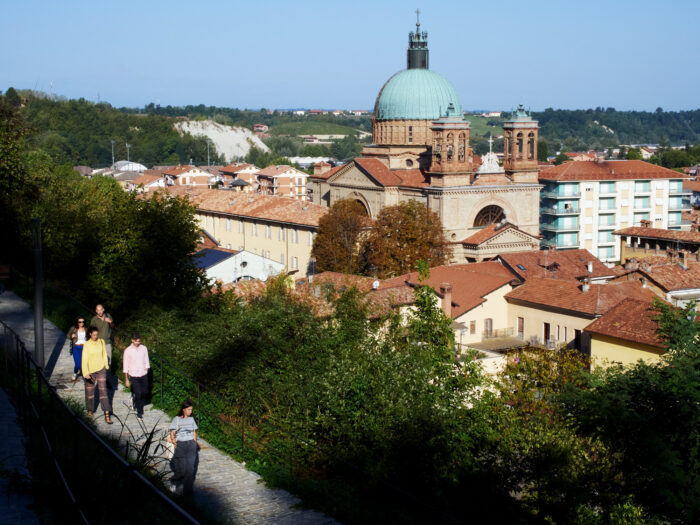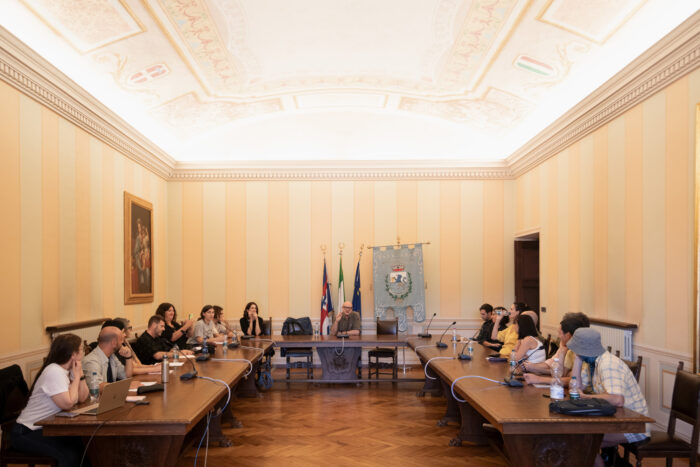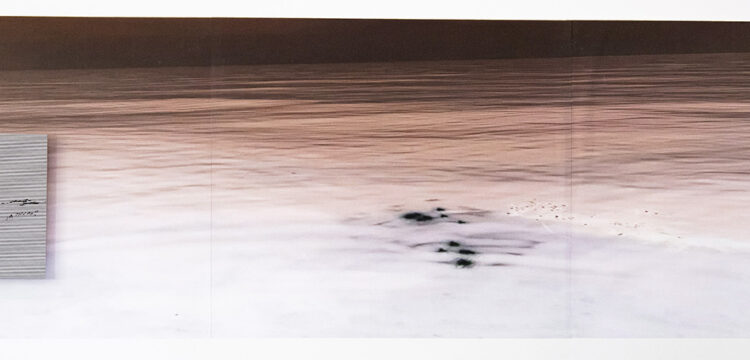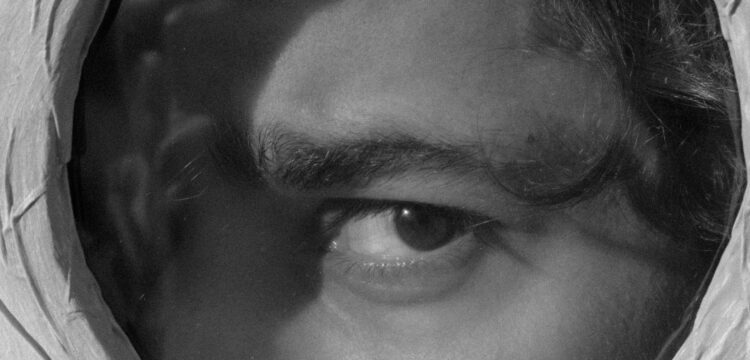The Para-Museum
A report on Supercondominio 7
In the undulating hills of Dogliani, between two valleys dotted with Dolcetto vineyards, along a narrow road on the peak of a hill, used to stand a house that functioned as a school. Today, on that very same spot, rises a new work of public art by Petrit Halilaj, embodying memory, encounter, and reflection on the interplay between radical education and art in the public sphere. That place, visible from afar, endures not only in the landscape but also in the memories of those who once inhabited it, as a monument to the secret traces left on desks and walls—a testament to the idea that learning, culture, and creativity are always relational, embedded, and lived in context. This transformation evokes the ethos of what Nora Sternfeld describes as the para-museum: spaces that move beyond traditional institutional boundaries to prioritize experimentation, dialogue, and public engagement. Like the para-museum, these independent projects—whether a former school, a library, or a temporary exhibition space—reimagine how knowledge, memory, and social practices can be activated in ways that are participatory, relational, and site-specific.
This ethos was brought to life during Supercondominio 7, the European assembly of independent art spaces, held in Dogliani and curated by Treti Galaxie. Gathering practitioners committed to experimental, educational, and relational practices, the event transformed the town into a living laboratory of artistic exchange. Over two days, spaces like Almanac, ARTECO, CLOSING SOON, Independent Space Index, LOCALES, Open School East, PIA School, Post Disaster, PUBLICS, and Toast Project converged to share, learn, and possibly start to collaborate.

At the heart of these practices is the belief that art is not merely an object to be observed but a site of encounter, a space where meaning is co-created through interaction. As participating artist Cleo Fariselli reflects, “We live in a time of transformation—fluid, unstable, perhaps even unreadable. I don’t think it’s essential to fully understand it. What feels urgent is to create occasions of connection: spaces where perception can shift, where attention can gather and embrace doubt, complexity, and even unintelligibility as an active act of contemplation.” In her performance U., Fariselli places small, unfamiliar objects in participants’ hands, inviting them to engage without predefined meanings, fostering a moment where habitual frameworks dissolve and new understandings emerge. She continues: “When I work with audiences beyond the art world, I don’t aim to simplify the experience or adapt its language. Rather, I try to create frames of access — playful, narrative, sometimes mysterious cues that can draw people in. In U., for instance, I physically place small, unfamiliar objects in people’s hands. They have no clear function or code; they are simply assembled for their poetic potential and their meaning arises only through the act of holding, passing, or observing them. Holding them produces a kind of attention that is both intimate and disorienting, a moment where one’s usual references quietly fall away. In that pause, something moves, and I find it full of potential. I’m not concerned with offering something dazzling or extraordinary, but with creating conditions in which the ordinary can appear alive with its own mystery. I look for that brief shift in awareness when the invisible becomes almost tangible. I think it is something simply human…”
The idea of unfinished definitions, constantly open to revisions, relates with the concept of impermanence, which plays a crucial role in these approaches. During one of the ongoing conversations, Valentina Roselli from ARTECO, used the metaphor of the sandcastle to describe a new possible reading for all the practices involved: “When I think of an emblem for public practices and relational work, it is the sandcastle. Its nature is negotiable and imperfect: sand, small pits, stones, shells, found objects, bodies, and hands shape it. Its building is often collective, guided by attention, intention, and small risks. Constantly exposed: it can be destroyed, claimed by the tide, its value rewritten. The inevitable collapse does not erase its meaning. What remains are the transformations born from encounter, gestures that linger, memories each person carries. It seeks no permanence; it teaches listening, vulnerability, mutual respect between parties, and shared responsibility. Deconstruction leaves traces of play, dissolution opens space for new imaginaries.” This metaphor highlights the transient yet impactful nature of their work, where the process and the interactions it fosters are as significant as the final outcome. Sergio Manca and Beatrice Zanelli of ARTECO further elaborate on their methodology: “Our work always begins with listening, which enables us to analyze the needs of the different audiences we address and design tailored experiences. We adopt a dialogical and participatory approach that shifts the focus from the object to the person, utilizing diversified methodologies to promote inclusion, protagonism, and active engagement.” An approach to surpass the idea of the audience as a passive recipient but an active participant in the artistic process, fostering a deeper connection and understanding.
Post Disaster’s project exemplifies the power of temporary interventions in public spaces. By transforming rooftops in Taranto into ephemeral cultural centers, they create moments of collective experience that, while short-lived, leave lasting impressions. As Gabriele Leo sai “In our curatorial statement, there is a sentence that reads: “PDR is a collective performance, situated and concerned with spatial claim. It is characterized by this building movement that, just before it establishes itself, dismantles without ever becoming a monumental space. The ephemeral—and, in a sense, precarious—condition is an intrinsic component of ROOFTOPS. It also reflects the way the practice began: inviting artists and audiences onto rooftops for which I had permission to use for a limited time, sometimes a month, other times just a few hours. From this perspective, the audience is an integral part of this collective activation. People climb the rooftops together, and together they transform—for a brief moment—the meaning of an existing spatial infrastructure. Everyone knows it will not last, yet it generates a new way of seeing that stays with us. Over time, we expanded this approach to encompass the whole city and eventually the surrounding territory. In the latest episode, we inhabited an abandoned shipyard for three consecutive days. For three days, it became a sort of cultural hub hosting performances, readings, and talks. Perhaps neither we nor our audience will ever return there, but the collective experience within these spaces layers itself into the imaginary of the practice.” These interventions challenge the permanence often associated with art and highlight the value of transient experiences in shaping public consciousness. The project operates in socially and culturally marginalized urban areas, where the idea of “art for art’s sake” is set aside, and instead, programs are designed to be open and accessible, sometimes even modifying artistic language—for example, avoiding English to ensure inclusivity. These “surprises,” as the team notes, often reveal unexpected engagement and offer critical feedback to refine the curatorial approach.
Artist-run spaces such as CLOSING SOON, located in Athens’ Kato Petralona district, engage with what we can call “minimum production”— exhibitions built with as few resources as possible, often hosted in unconventional or fleeting settings. By using demolished buildings or unassuming neighborhood sites, CLOSING SOON turns cost-constraint into aesthetic strategy, responding conceptually to the logic of over-production in art. One notable intervention occurred between the city’s main contemporary art museum—EMST—National Museum of Contemporary Art—and the Acropolis: a restored graffiti on a hotel facade reading “welcome and enjoy the ruins” and realized during documenta 14, visible from the museum terrace, modelling art that both lives in and comments on the urban fabric.
If CLOSING SOON redefines exhibition-making through scarcity and urban immediacy, LOCALES approaches curating as a practice deeply entangled with the social and political urgencies of the present. Reflecting on the challenge of engaging with audiences beyond the art world, the collective observes:
“The question of methodologies and attracting or addressing ‘non art related audiences’ is one that we find ourselves having to answer for every funding application we submit. And indeed, this is a complicated question to answer from a strictly methodological perspective. Perhaps this is because methodologies can indeed be adopted and applied, yet ultimately everything depends on the artistic and curatorial practices themselves; on the artist’s urgencies in relation to the present and to the major crises that shape the contemporary and speak to people.”
This statement encapsulates LOCALES’s commitment to curatorial work as both situated and critical, grounded in the complexity of the present. Their engagement with the public is not merely a matter of accessibility but a fundamental rethinking of who constitutes an audience and how art operates within civic life. Chiara and Sara explain:
“We engage in a series of practical methodologies in order to work with diverse audiences (diverse in terms of cultural background, ethnicity, social class, gender, social status); for example, all our activities are free of charge and accessible both in terms of content, language and practical forms of accessibility such as being close to public transport or taking place at times of day in which more people are free from work engagements. Not every activity allows for all these criteria to be met, but these are the things we always have in mind as a starting point. We also strive to complicate understanding of the audience/participant. A person that works in the Museo delle Civiltà is strictly speaking within the artistic field, however they may not have been included in many of the discourses that can shape a ‘museum of culture.’ So, bringing audiences, community members, and museum workers of all kinds in the same room is a way of addressing difficult heritages—such as colonial collections and fascist urban context. By operating often in the open air of urban contexts, parks, neighborhoods, in the proximity of public monuments, through walks or lecture performances, we invite new reflections and perspectives onto sites that are already layered upon by daily life, while also being untouchable due to the monumentalization of Rome’s every corner. In such a way the effort is to recast spaces of the past also into places of the present. Another crucial aspect is conviviality and affectivity as forms of responsible shared participation that go beyond the notion of the ‘event.’ Examples include the collective act of cooking and sharing food as a space for political and ecological reflection—as in the encounters with artists Emily Jacir and Michael Rakowitz, or with Amelie Aranguren (INLAND)—as well as practices often considered ‘minor,’ such as the puppet theatre developed in collaboration with Daniela Ortiz. Lastly something should be said about our approach to pedagogy. We have shared time and actively learn from artists whose research involves non-competitive forms of pedagogy and of being together to reflect on something or work towards a result. These include Adelita Husni Bey, and Lara Khaldi and Noor Abed’s of School of Intrusions, whose non-hierarchical approach to learning and moving through places, themes, ideas, has informed our own ways of engaging with diverse groups whose direct interest does not necessarily lie in contemporary art.”

Invited artist Elena Mazzi echoes this sentiment in her performative portfolio review at Bruno Zevi’s designed Biblioteca Civica Luigi Enaudi. Emphasizing the importance of listening and observation in her practice, she reflects “In each project I do—often related to specific communities or small groups of people—I take time to engage with them, to learn from them. That is why each project is different, and that is why I learn so much. I believe art is an exchange process, a give-and-take action I do as a daily activity. In these moments of exchange, I often use little exercises to find my way through: they can take the form of readings, actions of sharing, a combined use of space and objects. That is why architecture and design are very important in my work; I take elements from these disciplines and I recombine them in several ways. Mediating and learning go together, and I see mediating as a disseminating and participatory process, where new forms of exchange are found.” Her work underscores the idea that art is a dynamic, reciprocal process, shaped by the communities it engages.
PUBLICS, based in Helsinki, Finland, is an independent curatorial agency whose name highlights the multiplicity of audiences and the collective nature of cultural engagement. Operating as a library, exhibition space, and research platform, PUBLICS fosters dialogue between artists, curators, and the wider community. Among its initiatives is PUBLICS Youth, a program for young people aged eighteen to twenty-one, offering workshops, collaborative projects, and direct engagement with contemporary art and curatorial practice. Under the guidance of founder Paul O’Neill, PUBLICS has developed a model where research, exhibition-making, and education intersect, emphasizing inclusivity, critical thinking, and co-creation of cultural knowledge. O’Neill’s curatorial scholarship and leadership, notably in The Culture of Curating and the Curating of Culture(s), have shaped PUBLICS into a space where youth participation and contemporary art practice converge, cultivating critical, socially engaged cultural actors.
Spaces like Open School East and PIA School further demonstrate the intersection of art and education. Open School East offers a two-year programming cycle exploring themes of collaboration, experimentation, and openness, providing artists with an informal, critical environment to develop their practice.
Polly Brannan, Open School East Artistic Director, affirms “To work in these settings and engage non-art audiences I have spent the last 20 years developing and learning from existing roaming and DIY approaches, such as mobile working units, poster making, community-led publishing and more, tools that enable me to build relationships with communities at a hyper-local level. In the context of OSE in Margate, UK, we use these tools to build infrastructures, in direct dialogue with local communities, that improve access to green space, protect spaces for vital services, and support the development of advisory groups to enable local residents to lobby for change.”
Similarly, PIA School combines mentorship, portfolio reviews, and critical discourse to create an international exchange that fosters growth and dialogue among artists. Across these initiatives, the focus is not merely on transmission of knowledge but on cultivating relational practices where learning and creativity emerge in tandem.
Supercondominio7 exemplifies a model where art and education are intertwined, where public space becomes a site for collective learning and engagement. Through ephemeral interventions, dialogical practices, and a commitment to listening and observation, these independent spaces are redefining the boundaries of art and education, creating environments where meaning is co-created and where every participant has a role in shaping the experience.
“Somehow, curating Supercondominio reminds us of NEG, a quite obscure artwork conceived by Vincenzo Agnetti in 1970,” Treti Galaxie tells me. “It was a tech device that was able to play the pauses of a given music track, turning silence into sound, in order to draw attention to the negative space of a composition. And that’s what we try to do here: we give projects we believe in the opportunity to play their music, and at the same time we ensure to make also the breaks between presentations meaningful, as these are the moments when the most significant relationships are forged and friendships begin.”
The gathering in Dogliani was not just a series of isolated events but a collective endeavor to reimagine the role of art and education in public space. As one participant noted, the event served as a writing tool and space for a community of practice in fermentation, likening it to natural wine: a product without additives, unpredictable, undisciplined, and generative. This analogy underscores the organic, collaborative, and experimental nature of the gathering, where knowledge and understanding were cultivated through shared experiences and interactions.
Years ago, a dear friend and artist (Luca Trevisani), knowing my obsession with the prefix “para,” wrote me a small statement and glossary-like definition that I would like to share here to conclude this text and offer another possible metaphor for what we can still transform through our practices—especially when they operate with a long-term perspective, for a project with an almost indefinite timespan, ideally always supported by larger institutions.
“Para is that particle placed before a word that gives it a vague but defined sense, like para-medical, to clarify, which is indeed a doctor with curatorial functions, but without all the papers and bureaucracy that make them fully so. A suffix that conveys closeness, similarity, and therefore also reveals us as variants of something. Nearby, beside, beyond: paramuseum, paramilitary, parapharmacy. Para, on the other hand, is a natural rubber derived from the latex of certain wild plants in the Pará region of Brazil. On reflection, however, I must admit that para is a ‘para-rubber,’ a whimsical kind of rubber, more different than conforming to the industrial rubbers one might think of—like car tires or the faithful silicone rubbers used to make molds precise to the smallest details. Para-rubber is used for shoe soles. I remember a pair of beautiful sneakers with sculpted toes, whose soles, come spring, had become a sticky latex like a lollipop. It seemed they gained life and courage day by day, and I, astonished and surrendered to an animism of soles, could no longer wear them; they stuck to the ground leaving greasy, sticky marks, producing sounds like someone chewing without teeth, soft and muffled. Shoe-soles merging with the floor, a monument to stillness, a viscous paradox. The power of para. Almost a magical tale, by a Brazilian shaman.”



